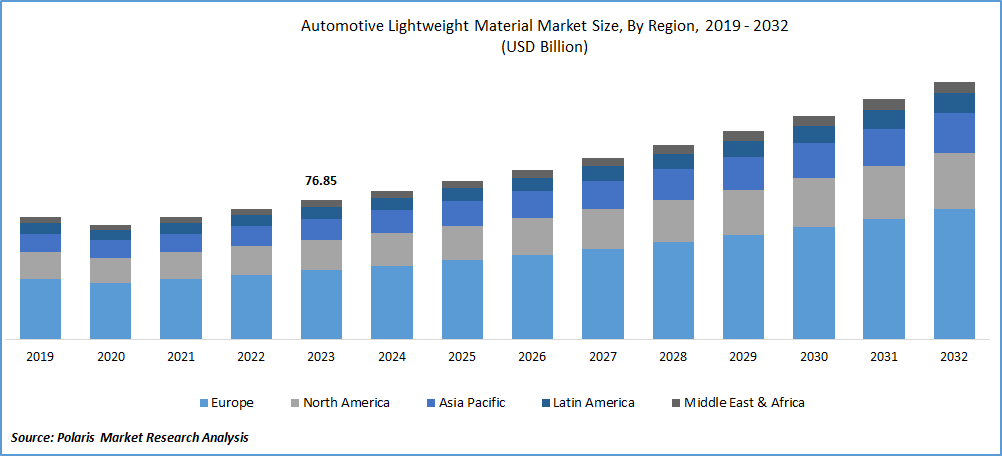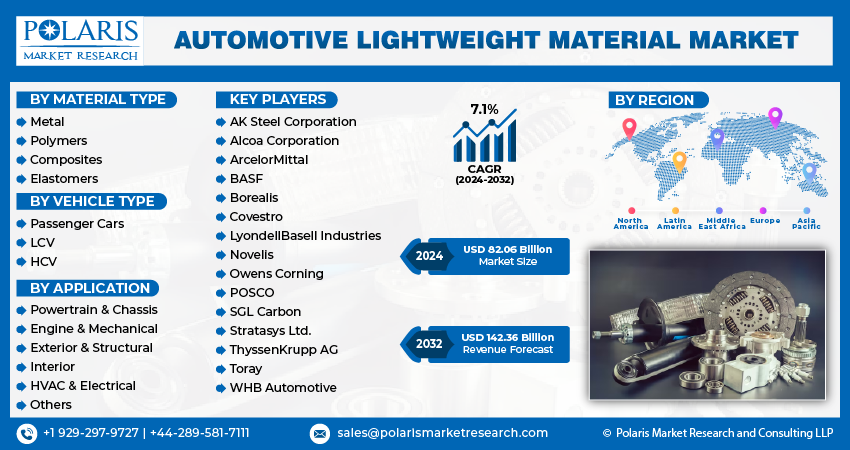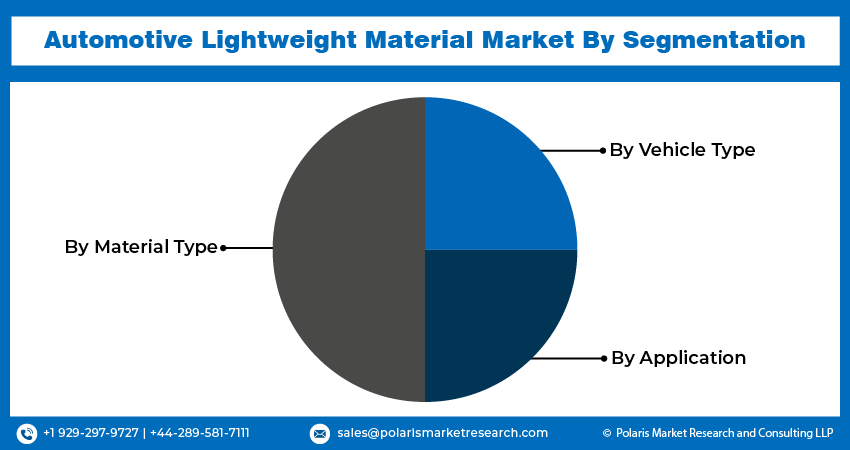
Automotive Lightweight Material Market Share, Size, Trends, Industry Analysis Report, By Material Type (Metal, Polymers, Composites, Elastomers); By Vehicle Type; By Application; By Region; Segment Forecast, 2024 - 2032
- Published Date:Feb-2024
- Pages: 117
- Format: PDF
- Report ID: PM1757
- Base Year: 2023
- Historical Data: 2019-2022
Report Outlook
The global automotive lightweight material market was valued at USD 76.85 billion in 2023 and is expected to grow at a CAGR of 7.1% during the forecast period.
Automotive lightweight materials refer to substances and composites specifically chosen and engineered to reduce the overall weight of vehicles while maintaining or enhancing their structural strength and performance. The automotive industry is increasingly focused on incorporating lightweight materials to address challenges such as fuel efficiency, emissions reduction, and improved overall vehicle dynamics. Common lightweight materials include metal, polymers, composites, and elastomers.
The escalating demand for electric and hybrid vehicles has increased the significance of lightweight materials, as lower vehicle weight directly results in extended battery range and improved overall performance. Advancements in material science and manufacturing technologies have also propelled the growth of the market. Engineers and researchers are continually developing new composite materials, alloys, and manufacturing processes that offer the ideal combination of strength, durability, and reduced weight. This innovation is driving the adoption of materials like carbon fiber-reinforced polymers, aluminum, and high-strength steel in automotive design.

To Understand More About this Research: Request a Free Sample Report
Despite this, the automotive lightweight material market is hindered by higher initial costs associated with lightweight materials compared to traditional materials like steel. The complex manufacturing processes and increased raw material costs hurt the overall production cost of lightweight materials.
The research report offers a quantitative and qualitative analysis of the automotive lightweight material market to enable effective decision-making. It covers the key trends and growth opportunities anticipated to have a favorable impact on the market. Besides, the study covers segment and regional revenue forecasts for market assessment.
Growth Drivers
The Need to Lower Fuel Consumption Drives the Demand for the Market
The increasing need to lower fuel consumption drives the demand for automotive lightweight materials. The most effective strategy to enhance overall fuel efficiency is the adoption of lightweight materials in vehicle design and manufacturing. Automotive lightweight materials, such as advanced composites, aluminum, and high-strength steel alloys, play an important role in achieving weight reduction without compromising structural strength or safety.
According to the principle that lighter vehicles require less energy to get momentum, resulting in reduced fuel consumption and lower greenhouse gas emissions. The incorporation of lightweight materials results in the development of fuel-efficient vehicles, positively impacting both traditional internal combustion engine vehicles and emerging electric and hybrid models. In traditional vehicles, reduced weight leads to improved fuel economy, allowing manufacturers to produce vehicles that meet or exceed regulatory requirements. For electric vehicles (EVs), lower weight extends the driving range by maximizing the efficiency of the battery, catering to an important factor in customer acceptance and adoption of electric vehicles. Thus, the demand for the automotive lightweight material is increasing globally.

Report Segmentation
The market is primarily segmented based on material type, vehicle type, application, and region.
|
By Material Type |
By Vehicle Type |
By Application |
By Region |
|
|
|
|
To Understand the Scope of this Report: Speak to Analyst
By Material Type Analysis
The Metals Held the Highest Market Share in 2023
In 2023, metals dominated the market by holding the highest market share because metals are the preferred choice in the automotive industry, especially for achieving light-weighting goals. Lightweight materials play an important role in increasing fuel efficiency, reducing carbon emissions, and improving overall vehicle performance. The reason for the dominance of metals is their good strength-to-weight ratio.
Materials such as aluminum, magnesium, and high-strength steel possess good structural strength while being lightweight. This characteristic is essential for automotive manufacturers seeking to design vehicles that are not only fuel-efficient but also meet stringent safety standards. For instance, high-strength steel provides the necessary strength to ensure safety, while aluminum contributes to weight reduction. Also, metals offer cost-effective solutions compared to some alternative lightweight materials. Metals benefit from established manufacturing processes and economies of scale, making them more economically viable for mass production in the automotive sector.
By Vehicle Type Analysis
The Passenger Cars Segment Accounted for the Highest Market Share over the Forecasted Period
The passenger cars segment has held the highest market share since the unique requirements and preferences of the passenger car segment, showing the overview of the automotive industry. The demand for enhanced fuel efficiency and reduced emissions is more in the passenger car sector. Therefore, governments and consumers are increasingly focusing on environment-friendly and fuel-efficient vehicles. Lightweight materials play an important role in achieving these goals by reducing the weight of the vehicle, thereby improving fuel efficiency and lowering emissions. There is a more focus on design in passenger cars. Lightweight materials, such as alloys, composites, and polymers, allow designers to design vehicle profiles without compromising safety and performance. This is especially crucial in the passenger car segment, where style and visual appearance are key factors that influence the consumer while purchasing the cars.

Regional Insights
Europe Region is Estimated to Hold the Highest Market Share over the Forecast Period
Europe region is estimated for the highest market share because of the regulatory initiatives, consumer preferences, and the robust presence of automotive manufacturers like Audi, BMW, Mercedes Benz, etc. The European Union has been at the front line of implementing strict emissions standards in the automotive industry. Lightweight materials contribute significantly to achieving lower vehicle weights, which aids automotive manufacturers in meeting the strict carbon dioxide (CO2) emission levels set by regulatory bodies. As European nations continue to prioritize environmental safety, the demand for automotive lightweight materials is expected to remain high.
Along with this, Europe possesses a robust automotive manufacturing sector with a strong focus on innovation and technology. Automotive manufacturers in the region are investing in research and development to create vehicles that not only comply with regulatory standards but also cater to consumer demands for advanced features.
The Asia Pacific region is anticipated to experience significant growth over the forecast period in the market because the region is considered the point of focus point for advancements and adoption of lightweight materials. The rapid expansion of the automotive market in the Asia Pacific countries like China and India continues to grow because there is an increase in consumer’s purchasing power and a rising demand for automobiles. With this surge in automotive production and sales, there is a need for technologies and materials that contribute to fuel efficiency. To meet these requirements, the manufacturers are constantly looking for materials that will lower the weight and increase the fuel efficiency of the vehicles which in turn pushes the sales of automotive lightweight materials in the region.

Key Market Players & Competitive Insights
Manufacturers in the global automotive lightweight material market are actively engaged in various strategic activities to stay competitive and meet the changing demands of the automotive industry. Continuous investment in research and development to innovate and introduce new lightweight materials and manufacturing processes is done by key players in the market. Manufacturers are increasingly incorporating advanced materials, such as carbon fiber composites, aluminum alloys, and high-strength steel, into their vehicle designs to achieve significant weight reduction without compromising structural strength and safety.
Some of the major players operating in the global market include:
- AK Steel Corporation
- Alcoa Corporation
- ArcelorMittal
- BASF
- Borealis
- Covestro
- LyondellBasell Industries
- Novelis
- Owens Corning
- POSCO
- SGL Carbon
- Stratasys Ltd.
- ThyssenKrupp AG
- Toray
- WHB Automotive
Recent Developments
- In July 2022, Haitian Group, a machinery manufacturing company, officially launched a magnesium alloy injection molding equipment.
- In August 2020, Covestro, a manufacturer of high-quality polymer materials, launched automotive lightweight composite solutions to develop lightweight, durable parts for vehicles.
Automotive Lightweight Material Market Report Scope
|
Report Attributes |
Details |
|
Market size value in 2024 |
USD 82.06 billion |
|
Revenue Forecast in 2032 |
USD 142.36 billion |
|
CAGR |
7.1% from 2024 – 2032 |
|
Base year |
2023 |
|
Historical data |
2019 – 2022 |
|
Forecast period |
2024 – 2032 |
|
Quantitative units |
Revenue in USD billion and CAGR from 2024 to 2032 |
|
Segments Covered |
By Material Type, By Vehicle Type, By Application, By Region |
|
Regional scope |
North America, Europe, Asia Pacific, Latin America, Middle East & Africa |
|
Customization |
Report customization as per your requirements concerning countries, regions, and segmentation. |
Want to check out the automotive lightweight material market report before buying it? Then, our sample report has got you covered. It includes key market data points, ranging from trend analyses to industry estimates and forecasts. See for yourself by downloading the sample report.
FAQ's
Automotive Lightweight Material Market Size Worth USD 142.36 Billion By 2032
The global key players in Automotive Lightweight Material market include AK Steel Corporation, Alcoa Corporation, ArcelorMittal, BASF, Borealis, LyondellBasell Industries
Europe is the region contribute notably towards the Automotive Lightweight Material Market.
The global automotive lightweight material market is expected to grow at a CAGR of 7.1% during the forecast period.
Automotive Lightweight Material Market report covering key segments are material type, vehicle type, application, and region.
